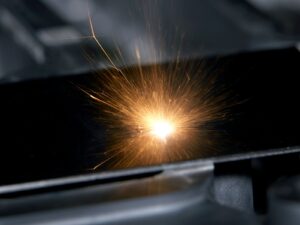What are the advantages of laser marking?
Laser marking, the process of using lasers to engrave or mark surfaces, has gained widespread popularity due to its numerous advantages over traditional marking methods. This technique is employed for various applications, including adding human-readable information for traceability, incorporating 2D codes to provide additional data on products, or simply marking logos. Laser marking stands out for its efficiency, versatility, and durability, making it the technology of choice where quality is paramount. The recent reduction in laser costs, driven by IPG, has made laser marking systems highly affordable. In this blog post, we’ll delve into the key advantages that make laser marking a superior choice in the realm of surface marking.
Speed and Efficiency
Laser marking is a fast and efficient process that can mark multiple parts simultaneously, saving time and increasing productivity. This is particularly important in industries where high throughput and rapid processing times are required. With laser marking it is also possible to mark components ‘on-the-fly‘ and achieve a marking rate of up to 4 parts in 1 second. Additionally, laser marking is a non-contact process, which eliminates the risk of damage to delicate or fragile parts, ensuring higher yields and reduced scrap rates and also means that complicated fixturing is not required.
Precision and Accuracy
Laser marking offers unparalleled precision and accuracy in marking various surfaces. The laser beam is extremely fine and can create very small, intricate designs and markings that would be impossible to achieve with other methods. This makes it ideal for marking small parts, including those with complex geometries. The accuracy and precision of laser marking are particularly important in industries where even the slightest error can result in product failure or safety concerns. This precision is achieved by using a focused beam of light, which can be adjusted to achieve different depths and widths of markings.
Durability and Longevity
Another major advantage of laser marking is its durability and longevity. The markings created by laser are permanent and will not fade or wear off over time. This makes them ideal for industrial applications, where the products are subjected to harsh conditions, such as exposure to chemicals, extreme temperatures, or high levels of wear and tear. The permanence of laser markings also ensures that important information such as serial numbers, 2D codes, and logos remain legible throughout the product’s lifespan.
Versatility
Laser marking is a versatile technique that can be used to mark a wide range of materials, including metals, plastics, ceramics, and composites. This versatility makes it an attractive option for a variety of industries, including automotive, aerospace, medical, and electronics, among others. Moreover, laser marking can be used for both surface and deep marking, allowing for a wide range of applications across all industry sectors
Environmentally Friendly
Unlike some traditional marking methods, such as inkjet or chemical etching, laser marking is an environmentally friendly process. It does not normally produce any toxic fumes or waste, making it a sustainable and eco-friendly solution. Additionally, laser marking does not require any consumables, such as ink or chemicals, which further reduces waste and cost.
In conclusion, laser marking is a highly efficient, precise, and versatile marking technique that offers several advantages over traditional marking methods. Its durability, accuracy, and eco-friendliness make it an attractive option for a variety of industries. With advancements in laser technology, the applications for laser marking continue to expand, offering new possibilities for manufacturers to improve their products and process, whilst ensuring that part traceability requirements are met.
